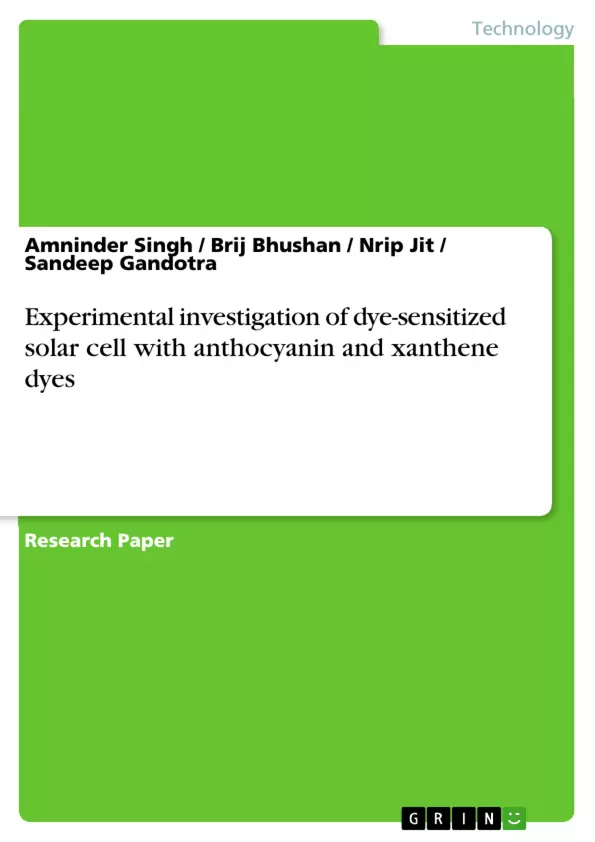Dye-sensitized solar cells are fabricated from xanthene (eosin yellow) and anthocyanin (pomegranate seeds) dyes. TiO2 films as an electron transfer material on Fluorine doped tin oxide glass layers were prepared by doctor blading method. Carbon coated counter electrode material used as an electron injector material and liquid Iodide/Iodine electrolyte solution was used to inject the extra electrons in the cell and to complete the electrical circuit in the solar cell.
Eosin Yellow and pomegranate dyes used to increase the absorption of the TiO2. The electrical conversion efficiencies of solar cells determined with eosin yellow and pomegranate seeds were calculated as 1.48% and 0.10% respectively, on a sunny day in Beant College of Engineering and Technology, Gurdaspur.
Frequently asked questions
What are solar cells and how are they categorized?
Solar cells are devices that convert solar radiation into electrical energy. They are divided into three generations based on their performance:
- First Generation: High efficiency but costly due to silicon material.
- Second Generation: Lower performance but low fabrication cost using thin films.
- Third Generation: Hybrid cells like dye-sensitized solar cells (DSSCs), not limited by the Shockley Queisser Limit (SQL).
What is a Dye-Sensitized Solar Cell (DSSC) and how does it work?
A Dye-Sensitized Solar Cell (DSSC) belongs to the third generation of solar cells. It transforms light energy into electricity by sensitizing larger band gap semiconductor materials like TiO2 and ZnO2. The conversion depends on a dye that absorbs light, excites electrons, and injects them into the conduction band of the semiconductor.
What are the components of a DSSC and their roles?
The key components of a DSSC include:
- Conductive Oxide Glass: (FTO or ITO) serves as the substrate.
- Wide Band Gap Metal Oxide Layer: (TiO2) acts as an electron injector.
- Sensitizer (Dye): Absorbs light energy.
- Electrolyte Solution: Provides electrons and completes the circuit.
- Counter Electrode: Glass coated with platinum and carbon.
What is the operating principle of a DSSC?
The dye absorbs light energy, exciting electrons from the ground state to the excited state, then injecting these electrons into the conduction band of the wide band gap material. The oxidized dye receives an electron from the electrolyte solution, and the process repeats.
What is the experimental procedure for creating a DSSC?
The experimental procedure involves:
- Conductive Glass Preparation: Selecting and cleaning FTO glass.
- Electrode Preparation: Applying TiO2 paste onto the conductive glass using the doctor blade method and annealing it.
- Dye Preparation: Isolating anthocyanins from natural plants or preparing xanthene dyes.
- Counter Electrode Preparation: Applying carbon paste onto conductive glass using the doctor blade method and annealing it.
- Electrolyte Solution Preparation: Mixing potassium iodide and iodine in ethylene glycol.
- Assembly: Binding the TiO2 electrode and counter electrode together with binder clips and adding electrolyte solution.
How is the efficiency of a DSSC calculated?
The solar conversion efficiency (η) of a DSSC is estimated using the formula: η = Pmax / Pin, where Pmax is the maximum output power and Pin is the input power. The fill factor (FF) is determined as: FF = Imax * Vmax / Isc * Voc, where Voc is the open-circuit voltage and Isc is the short-circuit current.
What were the optical results of the dyes used in the experiment?
The optical results from UV-VIS spectroscopy showed that titanium dioxide absorbed light in the ultraviolet region. Eosin yellow had maximum absorption in the visible zone at 500 nm, while promengrate juice had maximum absorption in the UV and visible zones at 200 nm and 400 nm.
What were the electrical conversion efficiencies of the solar cells made from eosin yellow and promengrate juice?
The electrical conversion efficiencies of the solar cells made from eosin yellow and promengrate seeds were calculated as 1.48% and 0.10% respectively.
What are the benefits of using natural dyes in DSSCs?
Natural dyes are easily available, easy to prepare, environmentally friendly, and can improve light absorption when combined with materials like titanium dioxide. They contain carbonyl (C) and hydroxyl (OH) groups that bond to the TiO2 surface, facilitating electron transfer.
What is the acknowledgement for this study?
The authors express special thanks to the Head Department of Mechanical Engineering of Beant College of Engineering and Technology Gurdaspur for providing facilities for research work in their solar energy laboratories and to the faculty members for their help and valuable suggestions.
- Quote paper
- Amninder Singh (Author), Brij Bhushan (Author), Nrip Jit (Author), Sandeep Gandotra (Author), 2016, Experimental investigation of dye-sensitized solar cell with anthocyanin and xanthene dyes, Munich, GRIN Verlag, https://www.hausarbeiten.de/document/336152


